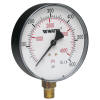 Before any potable water piping can be put into service a pressure test must be completed. Testing is required by code and may be witnessed by your local inspector for verification. There are two primary methods used for pressure testing water lines and they are:
Before any potable water piping can be put into service a pressure test must be completed. Testing is required by code and may be witnessed by your local inspector for verification. There are two primary methods used for pressure testing water lines and they are:
Pressure test using water
Testing water distribution lines under normal operation and pressure is the most common and easiest method to prove the installation sound. This test is done; preferably, when all the piping and joints are visible and before underground supplies are backfilled. Rules for potable water pressure tests:
- Only potable water can be used to test potable water distribution pipes.
- All air must be removed from the system through valves and fixtures.
- The normal operating supply pressure is adequate for testing purposes.
- Visually inspect every fitting and connection for leaks, recheck for small leaks after an hour, especially on threaded connections.
- If sections of the system are blocked from view, insert a pressure gauge along some part of the system, pressurize then isolate the system. Record the initial reading and check after 2 hours for any loses.
Pressure test using air
In sub zero temperatures an air test is the recommended method for testing water lines. To conduct an air pressure test acceptable by the code and inspectors, follow these steps:
- Isolate the section of water lines you are testing and install the required fittings to hook up an air compressor. Install a ball valve between the compressor and the system. Install a pressure gauge that reads above 100 psi.
- Ensure the compressor will not allow any contamination into the system, such as oil. Fill the compressor and purge the tanks from the condensation valve/port.
- In order for the system to pass an air test by the Canadian plumbing code, the system must be filled to 700 kpa or 100 psi, and maintain the pressure for no less than 2 hours.
- Air leaks are harder to find and may require the use of an approved potable leak detection liquid.
Any drops in pressure or leaks discovered will obviously require repair and another pressure test to ensure the distribution system is water tight.
